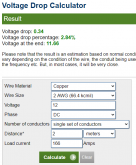ianganderton
Auckland, NZ
I made it up since you seem to understand the math for calculating the resistance (r=pL/A), so I avoided that altogether to try and simplify things by saying it was 1 ohm per foot of wire.
But, if you want to do a real example calculate R1 & R2 for two given distances along the same piece of wire. Then calculate V1 and V2 for a given current at those distances. Then the voltage drop for the distance is just V2 - V1. Once you've got that, hopefully you'll see that if L1 is 0, V1 is zero... so you can simplify the math to calculate the voltage drop by leaving out L1 and R1.
First off I really appreciate you taking the time to go though this and sincerely apologise for being so stupid
I understand the maths for resistance but I don’t understand how to get it if I don’t know the area (cable size)




